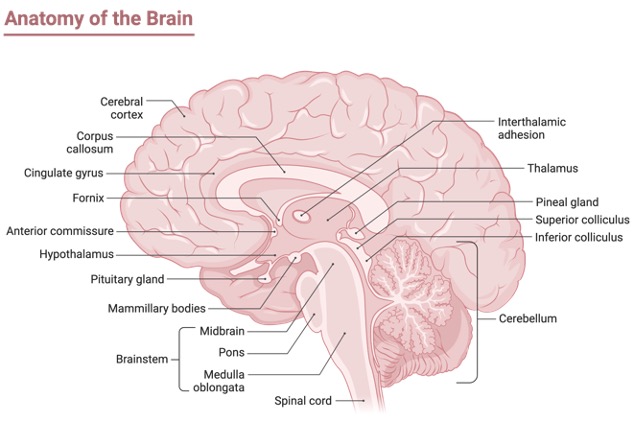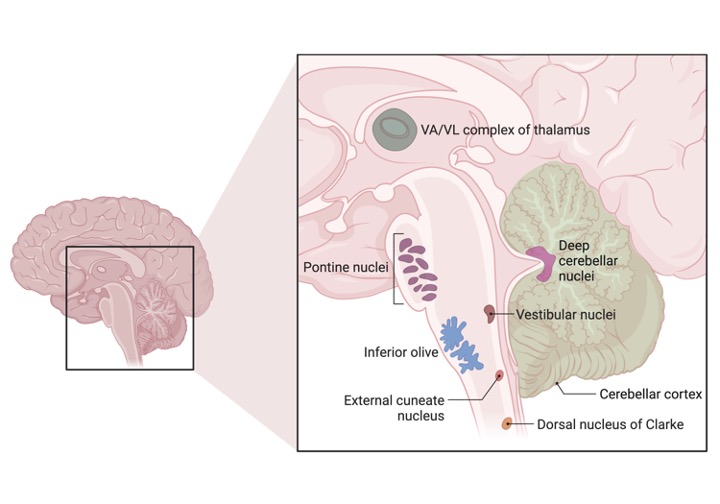Table of Contents
Thalamus Definition
A paired, symmetrical structure is called the thalamus. It is found at the base of the cerebrum, located above the brain stem. The flow of information from the spinal cord, brain stem, and other brain regions is regulated by the thalamus to the appropriate location in the cortex, thus it acts as a relay station.

The thalamus has various important functions in the central nervous system and the limbic system. It plays role in pain response, sensory perception, and emotional regulation.
Thalamus Location
The thalamus is a paired structure, which is located just above the brain stem in the cerebral hemisphere.

The location is in the exact center of the brain and each brain hemisphere consists of one part of the structure. The diencephalon, which is a part of the forebrain is formed by the thalamus.
Thalamus vs Hypothalamus
The hypothalamus is confused with the thalamus due to its names. However, both the structures have differences and they are named just because of their location. The thalamus is located just above the hypothalamus (hypo- means ‘under).
In most organisms, homeostasis is regulated by the hypothalamus because it is closely connected to the pituitary gland. Whereas, the thalamus has the main function to relay sensory information to the appropriate part of the brain.
Anatomy of the Thalamus
The structure of the thalamus is bilateral and symmetrical. The components of the thalamus are shaped like an American football. Various structures from the thalamus named nuclei that have projections into various parts of the brain.
Different type of information is received and transmitted by these nuclei, which are made up of neurons, especially thalamic relay neurons. Based on their location, the nuclei are grouped into anterior, medial, or lateral.
Thalamus Function
The major function of the thalamus includes the transfer of information therefore it is called a relay station. It is considered a part of the central nervous system. CNS is the part of the nervous system from where the information passes to the relevant part of the body.

Thalamus is also an important part of the limbic system. The functions of the limbic system include processing emotion, pain response, and higher cognitive functions. Consciousness and alertness in also thought to be regulated by the thalamus, and it also contributes to controlling the sleep-wake cycle.
Different types of information are passed to the appropriate targets by different nuclei within the thalamus. The signals from different areas of the brain are received by the excitatory neurons and then pass to the appropriate location of the cortex.
The examples of nuclei and their functions are listed below:
Anterior Nuclei: The collection of nuclei found at the back of the thalamus is called the anterior nuclei. The hippocampus is associated with the anterior nuclei and plays an important role in regulating emotions and also helps in learning and episodic memory storage.
Dorsomedial Nucleus: A large nuclei of the thalamus is called the medial dorsal nucleus or the dorsomedial nucleus. The main functions of this nucleus include regulation of emotional behavior and memory and cognitive functions such as reward associations and decision-making.
Ventrolateral Nucleus: The ventrolateral nucleus also plays significant roles especially involved in motor functions. The coordination and planning of movement, learning movement also involve the ventrolateral nucleus. The lesions in this area are also associated with the strange perception phenomenon known as synthesis. In this phenomenon, the individuals associate one sensory input with a second such as ‘feeling’ music, or ‘seeing’ sounds.
Ventral Posterolateral Nucleus: The part of the ventral posterior nucleus is made by the VPL or the ventral posterolateral nucleus. The main function of VPL is in receiving sensory information from the body and transfer it to the brain cortex. An example of its function includes relaying information about external temperature or other signals such as touch, itching, etc.
Ventral Posteromedial Nucleus: It is also a part of the ventral posterior nucleus. The function of VPM includes receiving sensory information from regions of the face and mouth. It also plays a role in regulating taste.
Reticular Nucleus: A capsule around the structure of the thalamus is formed by the thalamic reticular nucleus. The inhibitory interneurons make this nucleus, instead of relay neurons. The neurons project into the other nuclei and do not have projections into the cortex, which modulates their activity.
Clinical Relevance of Thalamus
The dysfunctions of the thalamus can cause a few and rare disorders in organisms.
Thalamic Pain Syndrome: It is also known as Dejerine- Roussy syndrome that is associated with stroke. It is a rare syndrome that usually occurs after a thalamic stroke that causes any damage to the thalamus. The symptoms of this disease include numbness and tingling of the affected side, and pain and burning sensations, hypersensitivity.
Fatal Familial Insomnia: Neurodegeneration is caused by the rare genetic disorder called fatal familial insomnia of FFI. The disease causes misfolding of a protein called prion protein. The thalamus is mostly affected by this misfolding that lead the neurons within it to die. The symptoms of FFI include dementia, insomnia, anxiety, and rapid weight loss, at the end the patient may suffer from delirium and find difficulties while talking and walking, and not able to sleep entirely. This disease cannot be cured and also does not have any treatment to slow the disease.
Korsakoff Syndrome: The deficiency of vitamin B1 cause Korsakoff syndrome in individual. The disease has symptoms including amnesia, apathy, and confabulation. The thalamus needs thiamine for its proper functioning and metabolic processes, thus the deficiency of thiamine causes a lack of energy and can die.
Obsessive-Compulsive Disorder: The altered brain anatomy has been linked with obsessive-compulsive disorder. It is a mental health disorder that causes due to enlarged thalamus. The disorder can be cured or the volume of the thalamus can be reduced by cognitive behavioral therapy.







